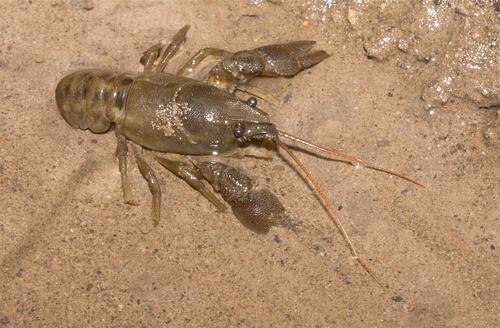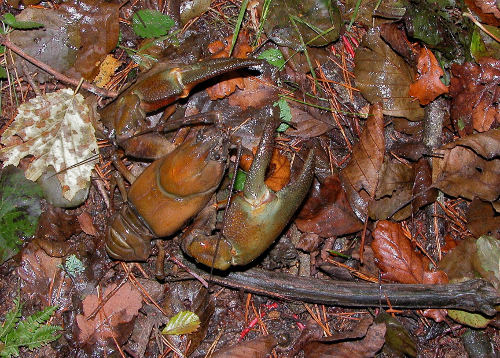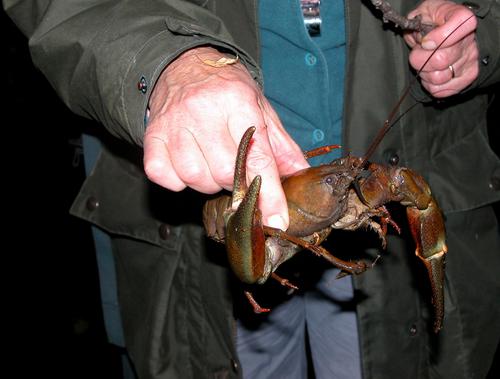Atlantic Stream (white-clawed) crayfish Austropotamobius pallipes in Wyre Forest
Ann Hill
The white-clawed crayfish Austropotamobius pallipes is the only native species of freshwater crayfish in the UK. It has a decreasing population and the species faces an uncertain future in England and Wales, where it is vulnerable to pollution, habitat destruction and competition from introduced crayfish. A recent sighting (during a cave spider survey in July 2010) suggested that there might be a native crayfish population in one of the tributaries of Dowles Brook. As a result, a baseline survey of the watercourse was undertaken to establish if the native crayfish was present and making a comeback to the Wyre Forest. The local native population of white-clawed crayfish was thought to be in decline (Linck 2000) although they had once been “abundant throughout the Dowles and tributary streams” according to Norman Hickin (1971) in his book on the natural history of the Wyre Forest.
The distribution of the white-clawed crayfish is governed by geology and water quality. The species can be found in a variety of locations including canals, streams, rivers, lakes, reservoirs and water-filled quarries, where it occupies cryptic habitats. They are largely nocturnal, with breeding taking place from September to November when water temperatures drop below 10°C for an extended period. The white-clawed crayfish is usually found associated with stony habitats containing obvious refuges in the form of gaps between and under rocks, macrophytes and marginal tree roots, particularly in streams and lakes with clear water and little marginal mud (Holdich 2003). If the banks are composed of suitable material, then they may also construct and live in burrows. The bottom substrate and presence of morphological structures acting as hiding places, and the geographical isolation of the habitat seem to be of importance.
There has been a significant decline in the reported distribution of white-clawed crayfish across England and Wales during the period 1997-2001 compared to the preceding period 1990-1996 (both inclusive) (Sibley, Brickland & Bywater 2002). The most widespread threat is that of invasive alien species, in particular the signal crayfish (Holdich et al. 2009). The signal crayfish is a vector for crayfish plague, a fungal pathogen which can spread rapidly through populations of white-clawed crayfish and has caused them to disappear from many parts of Britain (Holdich and Rogers, 1997a; Holdich et al., 1999). Signal crayfish are also aggressive predators for food and habitat, and often prey upon the white-clawed crayfish. Localised declines in white-clawed crayfish populations can also occur as a result of alteration to the hydrological regime of rivers, pollution from agriculture, domestic pollution, sedimentation, eutrophication, loss of in-stream cover such as tree roots and pebbles, droughts and changes in land-use activities.
The white-clawed crayfish is protected from ‘taking and sale’ under Schedule 5 of the Wildlife and Countryside Act 1981 (as amended 1992), listed under the EU Habitats Directive Annex II and V, included as a priority species under Appendix III of the Bern Convention and is listed as endangered on the IUCN Red Data List for endangered and threatened species. The species is also a priority species under the UK Biodiversity Action Plan (BAP), with a BAP steering group for white-clawed crayfish overseeing the delivery of a national action plan (UK Biodiversity Group 1995). The key objective of this Action Plan is to “maintain the present distribution of ... (A. pallipes)”, and fundamental to this aim is the requirement for an effective programme of distribution monitoring and reporting. The white-clawed crayfish is also a Worcestershire BAP priority species. The Worcestershire BAP Vision Statement is that “all known white-clawed crayfish populations being safe and secure and populations expanding to colonise all suitable rivers and streams”.
White-clawed crayfish is also indirectly affected by the EU Water Framework Directive which seeks to achieve good ecological status of aquatic systems.
A protected species licence is required for any surveys for white-clawed crayfish. Licences are issued by Natural England and the Countryside Council for Wales.
Method
A baseline crayfish survey of the tributary where the July 2010 sighting was made (Tributary A) and an adjacent tributary (Tributary B) of Dowles Brook was undertaken on 10 August 2010 using the standard manual search method (Peay 2002, 2003). Only one 100 m sampling site was surveyed in a 500 m stretch of each tributary. Five areas of habitat (termed ‘patches’) considered being the most favourable for crayfish were selected within each 100 m sampling site and ten potential refuges were manually searched in each habitat patch. A total of 100 refuges were manually searched in Tributary A and 50 refuges were manually searched in Tributary B. In addition, an uncounted number of casual searches were made during the survey and the results recorded separately. The manual survey recorded information on the relative abundance and population structure of the crayfish caught including size distribution and sex ratio. All caught crayfish were checked for signs of disease, incidence of claw loss and regeneration and other damage, and were returned to the watercourse.
Night viewing of Tributary A and Tributary B, and the linking stretch of Dowles Brook, was undertaken on four nights in August and September as a supplementary method to the above standard manual search. The torching method gives an abundance estimate of the white-clawed crayfish population. Timed 15-minute searches were made of the same two standard manual search sampling sites on 17 and 23 August. In addition, the down stream sections of Tributaries A and B and the linking stretch of Dowles Brook between Tributary A and B were night viewed, using timed 15-minute searches, on 31 August. Additional night viewing on the upstream stretches of the same two tributaries was undertaken on 13 September to try to establish the upstream extent of the white-clawed crayfish population. The stop watch was stopped and re-started where necessary.
All surveys were undertaken from the downstream end of each stretch. Difficult terrain, fallen timber and dense vegetation with associated health and safety issues prevented survey in places but a representative sample was taken. All surveys were carried out by, or under, the supervision of experienced license holders and all license conditions were complied with. Precautions were taken to prevent the spread of crayfish plague.
The water temperature was between 15° and 16°C for the daytime surveys and between 11° and 15°C for the night-time surveys. Flow conditions fluctuated between no obviously high flow conditions and reducing water levels after periods of rain.
Results
There were 382 white-clawed crayfish recorded in Tributary A and 39 white-clawed crayfish were recorded in Tributary B. No white-clawed crayfish were recorded during a short survey of Dowles Brook. A summary of the results of the daytime and nocturnal surveys are shown in Tables 1, 2 and 3. Please note that the torching records may include duplicate records from the day-time manual survey. Nevertheless this would still give a total of 366 records from Tributary A and 35 records from Tributary B.
Method | Refuges | Time | Sample Site Extent | Total white-clawed crayfish | Adults | Adult | Juveniles | |
Male | Female | |||||||
Manual Search | 100 | N/A | 200m | 8 | 0 | 6 | N/A | 2 |
Casual Search | N/A | 8 | 2 | 2 | N/A | 4 | ||
Torching | N/A | 6 x 15 minutes | 290 | N/A | N/A | 158 | 132 | |
Torching | N/A | 2 x 15 minutes | 140m | 73 | N/A | N/A | 26 | 47 |
Torching | N/A | 10 minutes | 105m | 3 | N/A | N/A | 3 | 0 |
Total white-clawed crayfish | 382 |
|
|
|
| |||
Table 1: Summary of white-clawed crayfish recorded in Tributary A, Wyre Forest.
Method | Refuges | Time | Sample Site Extent | Total white-clawed crayfish | Adults | Adult | Juveniles | |
Male | Female | |||||||
Manual Search | 50 | N/A | 150m | 2 | 1 | 0 | N/A | 1 |
Torching | N/A | 4 x 15 minutes | 2 | N/A | N/A | 0 | 2 | |
Torching | N/A | 11 minutes | 19m | 0 | N/A | N/A | 0 | 0 |
Torching | N/A | 3 x 15 minutes | 125m | 0 | N/A | N/A | 0 | 0 |
Torching | N/A | 15 minutes | 136m | 19 | N/A | N/A | 7 | 12 |
Torching | N/A | 15 minutes | 50m | 0 | N/A | N/A | 0 | 0 |
Torching | N/A | Approx. 20 minutes | 136m | 9 | N/A | N/A | 9 | 0 |
Torching | N/A | 15 minutes | 136m | 7 | N/A | N/A | 5 | 2 |
Total white-clawed crayfish | 39 |
|
|
|
| |||
Table 2: Summary of white-clawed crayfish recorded in Tributary B, Wyre Forest.
Method | Refuges | Time | Sample Site Extent | Total white-clawed crayfish | Adults |
| Juveniles | |
Male | Female | Adult | ||||||
Torching | N/A | 3 x 15 minutes | 125m | 0 | N/A | N/A | 0 | 0 |
Total white-clawed crayfish | 0 |
|
|
|
| |||
Table 3: Summary of white-clawed crayfish recorded in 125m stretch of Dowles Brook, Wyre Forest.
The white-clawed crayfish abundance per site from the manual search (calculated as the number of crayfish per 10 refuges) was for Tributary A calculated to be 0.08 and for Tributary B calculated to be 0.04. The average abundance of white-clawed crayfish recorded during the torching survey in each of the nine sampling sites along Tributary A was 41 crayfish per 15-minute search. The average abundance for each of the twelve sampling sites along Tributary B during the torching survey was three crayfish per 15-minute search.
Fourteen white-clawed crayfish were measured to the nearest mm from tip of the rostrum to the junction of the carapace and tail (daytime manual survey). The minimum carapace length was 5.05 mm and the maximum carapace length was 36.8 mm. The median size was 22.05 mm carapace length. The percentage of population classed as juveniles (juvenile = <25 mm carapace length) from the combined surveys in Tributary A was 48% and in Tributary B was 44%.
No evidence of disease in any of the recorded white-clawed crayfish was found. One female white-clawed crayfish was missing a left cheliped and another female had a missing antennae.
No evidence of non-native crayfish was found during any of the surveys.
Discussion
The remarkable and unexpected positive results suggest that the native white-clawed crayfish has returned to the Wyre Forest. The 2000 survey of Worcestershire watercourses found only one small population of white-clawed crayfish (4 female adults; 1 male adult, 2 dead adults and one escapee) in one of the tributaries of Dowles Brook, Wyre Forest (Linck 2000). The 2010 results indicate that there is a relatively large population of native white-clawed crayfish in Tributary A and a small population in Tributary B. The nocturnal torching is likely to give a much better indication of population abundance of this nocturnal species than the day-time manual survey method.
Both male and females were caught and measured in Tributary A and male only in Tributary B although the presence of juveniles implies the presence or recent presence of breeding females in Tributary B. As expected, adults slightly outnumber juveniles in both Tributaries; night viewing is biased towards active adult crayfish (Peay 2003). The proportion of juveniles was between 44% and 48% of the population which implies a strong population with effective recruitment. The proportion of juveniles (<25mm carapace length) from a healthy population is likely to be about 40% (Peay 2003). The size distribution of the population shows a healthy population and also indicates that the population is recovering or colonising. However, it is unknown whether the observed change in population abundance is due to natural factors or because of an external reason.
Sampling of the population of white-clawed crayfish has shown no evidence of disease. More importantly no evidence of the non-native crayfish was found in the watercourses searched.
Further research and survey work is planned to be undertaken in Worcestershire for this UK BAP priority species. The aim would be to improve knowledge of white-clawed crayfish distribution and abundance to allow effective conservation action. At the moment, there is limited up-to-date knowledge of the distribution of all species of crayfish, including introduced species within Worcestershire. I would welcome any details anyone has on native and non-native crayfish populations within Worcestershire or any other relevant information on the species. I can be contacted at ann@hillsecology.co.uk or via the Worcestershire Biological Records Centre.
Acknowledgements
My thanks to the survey assistants: Mike Averill, Graham Hill, Jane Scott, Brett Westwood and Rosemary Winnall who gave support and encouragement during the searches. Special thanks go to Jane and Rosemary during one survey night of very atrocious and adverse weather conditions. Rosemary Winnall also arranged access permissions.
References
FÜREDER, L., GHERARDI, F., HOLDICH, D., REYNOLDS, J., SIBLEY, P. AND SOUTY-GROSSET, C., 2010. Austropotamobius pallipes. In: IUCN 2010. IUCN Red List of Threatened Species. Version 2010.4. Available at: www.iucnredlist.org. Downloaded on 19 November 2010.
HICKIN, N.E. 1971. The natural history of an English Forest. The wild life of Wyre. Hutchinson, London
HOLDICH, D.M., 2003. Ecology of the white-clawed crayfish. Conserving Natura 2000 Rivers, Ecology Series No. 1. English Nature, Peterborough.
HOLDICH, D.M. AND ROGERS, W.D., 1997. The white-clawed crayfish, Austropotamobius pallipes, in Great Britain and Ireland with particular reference to its conservation in Great Britain. Bull. Fr. Pêche Piscic., 347, 597-616.
HOLDICH, D. M., GYDEMO, R. AND ROGERS, W. D., 1999. A review of possible methods for controlling alien crayfish populations. In: GHERARDI, F. AND HOLDICH, D. M. (eds.), Crayfish in Europe as alien species - how to make the best of a bad situation?, pp. 245-270. A.A. Balkema, Rotterdam.
HOLDICH, D.M. AND ROGERS, D., 1999. Freshwater crayfish in Britain and Ireland. Evironment Agency, Bristol.
HOLDICH, D.M., REYNOLDS, J.D., SOUTY-GROSSET,C. AND SIBLEY, P.J., 2009. A review of the ever increasing threat to European crayfish from non-indigenous crayfish species. Knowledge and Management of Aquatic Ecosystems 394-395: 1-46.
LINCK, K., 2000. Crayfish Survey (2000). A survey of watercourses within Worcestershire. Unpublished report for Worcestershire Wildlife Trust.
PEAY, S., 2002. A Standardised Survey and Monitoring Protocol for the White-clawed Crayfish in the UK. Life in UK Rivers LIF 02-11-37. EC LIFE Programme, DG Env.D.1., Brussels, Belgium.
PEAY, S., 2003. Monitoring the White-clawed Crayfish Austropotamobius pallipes. Conserving Natura 2000 Rivers Ecology Series No. 1. English Nature, Peterborough, UK.
SIBLEY, P.J, BRICKLAND, J.H. AND BYWATER, J.A., 2002. Monitoring the Distribution of crayfish in England and Wales. Bull. Fr. Pêche Piscic., 367, 833-844.
UK BIODIVERSITY STEERING GROUP, 1995. Biodiversity: The UK Steering Group Report. Vol. 2: Action Plans. White-clawed crayfish (Austropotamobius pallipes), 157-158. HMSO, London.


